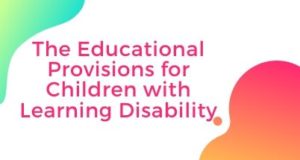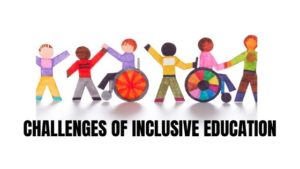Children with learning disabilities are those who are average intelligence. They generally face difficulty in learning to read, write, spelling, arithmetic, language skills and so on.
It is important to mention here that these children have these difficulties despite the appropriate academic and family environment. The cause of these difficulties is mainly dysfunction in the language area of the brain.
There are many types of learning disabilities, for example, dyslexia, dysgraphia and dyscalculia, dyspraxia, aphasia/dysphasia, visual processing disorder, auditory processing disorder and so on. This can be overcome through Special Education
Meaning of Learning Disability
Learning Disabled children are those who suffer from serious learning disabilities. These children exhibit natural inferior qualities or capacities in terms of learning or understanding in comparison to the normal children of their age or class.
Learning Disabled is nothing but a sort of helplessness felt by the sufferer in terms of his academic performance in the same way as experienced by a physically disabled child in terms of his physical function or by a mentally handicapped child in terms of his mental function.
Definition of Learning Disability
According to the Association for Children with Learning Disabilities, USA (1967), “A child with Learning Disability is one with adequate mental ability, sensory processes and emotional stability who has a limited number of specific deficits in perceptual, expressive process which severely impaired learning deficiency”
According to Kirk, “The term Learning Disability is not meant to be used for children with minor or temporary difficulties in learning but with the severe discrepancy between ability and achievement in educational performance and such severe discrepancy described as learning disability with significant learning problems that cannot be explained by mental retardation, sensory, impairment, emotional disturbance or lack of opportunity to learn.
Nature and Characteristics of Learning Disabilities
There are some important characteristics of Learning disabled children are:-
- Learning disabled children essentially suffer from serious learning problems or disorders for a number of reasons.
- Their problem and disorder are usually manifested by significant difficulties in the acquisition and use of language (listening, speaking, reading, writing etc), maths ability and social skills.
- They may exhibit symptoms of overactive
- Most of them may suffer from emotional problems and demonstrate signs of anxiety, moodiness or ups and downs in their behaviour
- Their learning disability is neither apparent in the physical appearance, nor demonstrable through their I.Q. scores. They may have a robust body, good vision and intelligence.
- They face lots of problem in their daily life such as Exhibit a significant educational discrepancy, ie between their learning potential and actual educational achievement
- They usually show the following learning characteristics responsible for their learning impairment (i) lack of motivation (ii) inattention, (iii) unable to generalize, and (iv) lack of adequate ability in problem-solving, information processing and thinking skills, etc
Cause of Learning Disabilities
The factors causing learning disabilities may be found to fall into the following three categories:
- Genetic and Heredity Factors: Many Characteristics commonly found in Learning disabled are transmitted from generation to generation. Emotional impulses, a disorder of memory and thinking have been found to run in families
- Organic Factors: Learning Disability arises due to minimal brain dysfunction which may happen due to cerebral haemorrhage, cerebral diseases due to high fever, head injury, premature birth etc
- Environmental Factors: Numerous environmental factors like physical, social, cultural and psychological have been traced as causes of Learning Disabilities.
Also Read: Principle of Growth and Development
Types of Learning Disability
There are many types of learning disabilities that can be attributed to language area dysfunction, for example, dyslexia, dysgraphia and dyscalculia, dyspraxia, aphasia/dysphasia, visual processing disorder, auditory processing disorder and so on. The table given below summarises the symptoms of these disorders.
| Dyslexia | Reading difficulty | A person with Dyslexia face Problem in reading, spelling etc |
| Dyscalculia | Diminished arithmetic ability | The problem in doing maths operations such as addition, subtraction and so on |
| Dysgraphia
| Writing Difficulty | The problem in writing,
Understanding spelling etc |
| Dyspraxia | Difficulty in coordination between mind and motor skills | Lack of coordination between the child’s motor skills, such as holding a pencil and writing something |
| Dysphasia/Aphasia | Language difficulty | The problem in language comprehension or accent of any particular language |
| Auditory and Visual Processing Disabilities | Sensory Disabilities | Pearson has the difficulty of normal hearing and vision |
Special Categories of Children with Learning Disability
Dyslexia
People with dyslexia face Problems in reading; they hesitate and read with a lot of effort. Reading is a challenging task in which they tend to miss out on Words and Sometimes, even whole lines.
Hence, They fail to comprehend the meaning of what they read. Dyslexic fried and fired etc. Their progress in reading tasks takes place very slowly. Phonetic reading problem is very common in such learners
They face difficulty when they try to combine letters to make a word. Therefore, their pronunciation also gets affected and gradually they develop poor, disorganised reading skills
The common symptoms of dyslexia include difficulty reading, speech sounds, slow reading and writing, problems with spelling
Dysgraphia
Dysgraphia is associated with writing skills and other similar activities. Children with dysgraphia show differences in their oral and writing skills. Their oral skills are better than writing skills.
They become confused by similar-looking letters such as b d, p q, n u, and difficulty in forming letters while writing. Their Words is very low and poor handwriting, Therefore, unable to express themselves effectively. Another important identification of these children is that they make a lot of mistakes while copying text from the blackboard or from the other printed materials
Dyscalculia
Dyscalculia is associated with maths skills. Even basic math is done incorrectly and very slow by learners with this disability. These learners fail to understand the sequence, steps and direction for solving simple arithmetic problems. They generally forgot the steps of sequence suggested by teachers to solve any math problem, symbols and other such concepts.
Dyspraxia
This is a disorder associated with motor nerve control, Where a child faces difficulty in coordinating the various fine motor skills. As a result, it affects the outcome of work done in the classroom. These children also have difficulty in creating clear communication between the body and the brain. Holding a pencil, or any such work that requires hand and eye coordination will be difficult for a dyspraxic child.
Aphasia/ Dysphasia
Aphasia or Dysphasia is associated with the difficulties of language and communication skills, where a child faces problems in the spoken language and sounds in words. Such children fail to communicate the correct version of their understanding of what they want to convey. They have a language learning disorder in which they find it hard to understand word meanings, follow directions and so on.
The educational provisions for children with learning disabilities will help such children to improve and sometimes overcome their learning disability to a certain extent.
Auditory and Visual Processing Disabilities
Sensory Disability in which a person has difficulty understanding language despite normal hearing and vision
Conclusions: We can conclude from the above point with the help of manpower and material resources available to the learning disabled children should help in overcoming their deficits and deficiencies in skills like spelling, handwriting, memory, maths skills, motor development and so on
FAQ
What is Dyslexia?
Reading Difficulty-Problem in reading, Spelling etc. Dyslexic learners face problems in identifying words that appear similar such as tried and tired, fried and fired etc.
What is Dyscalculia?
Diminished mathematical ability- Problem in doing mathematical operations such as addition, subtraction and so on
What is Dysgraphia?
Writing Difficulty-Problem in writing, understanding spelling etc.
What is Dyspraxia?
Difficulty in coordination between mind and motor skills. Lack of coordination between the child’s motor skills such as holding a pencil and writing something.
What is Dysphasia/Aphasia?
Language difficulty-Problems in language comprehension or accent of any particular language


